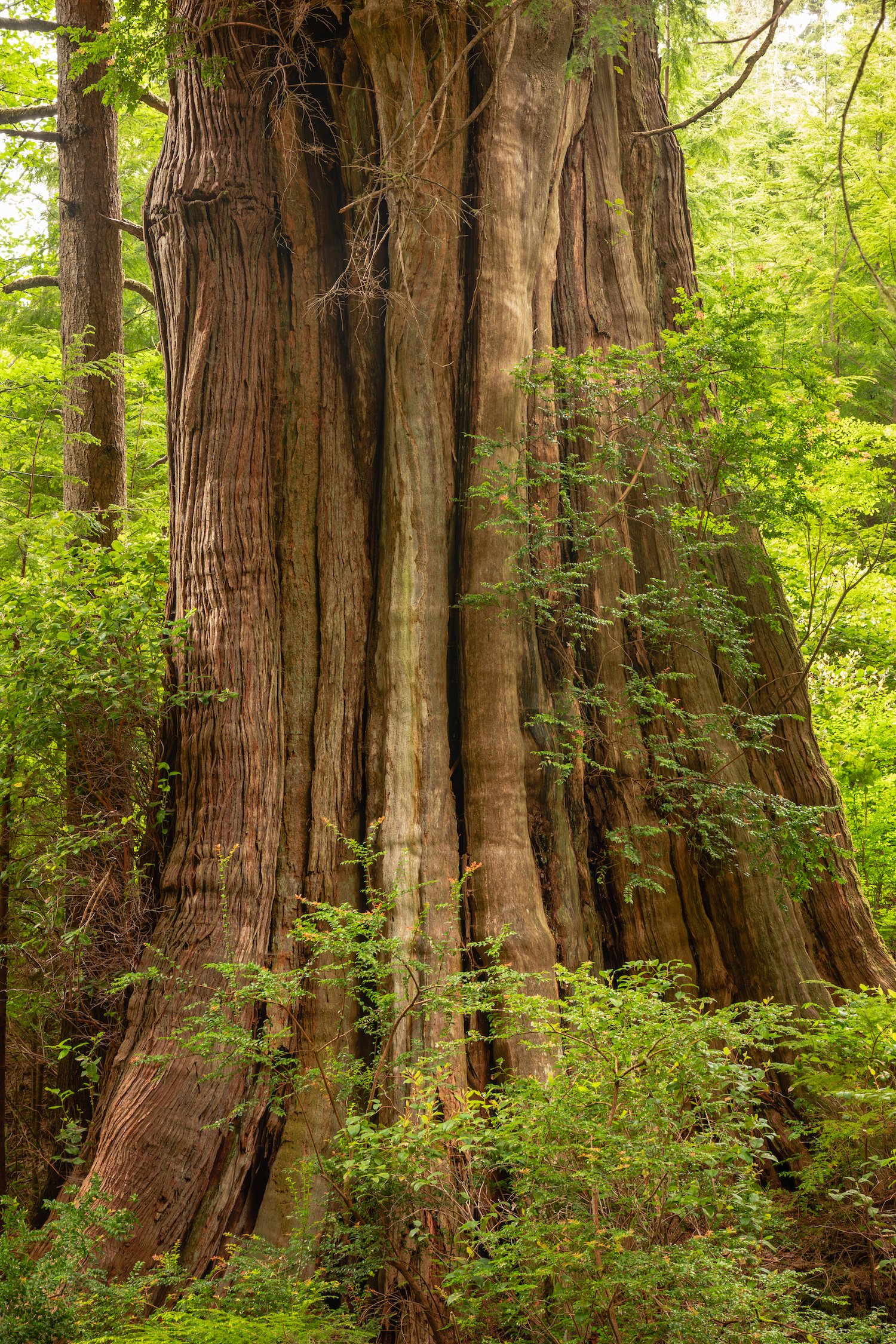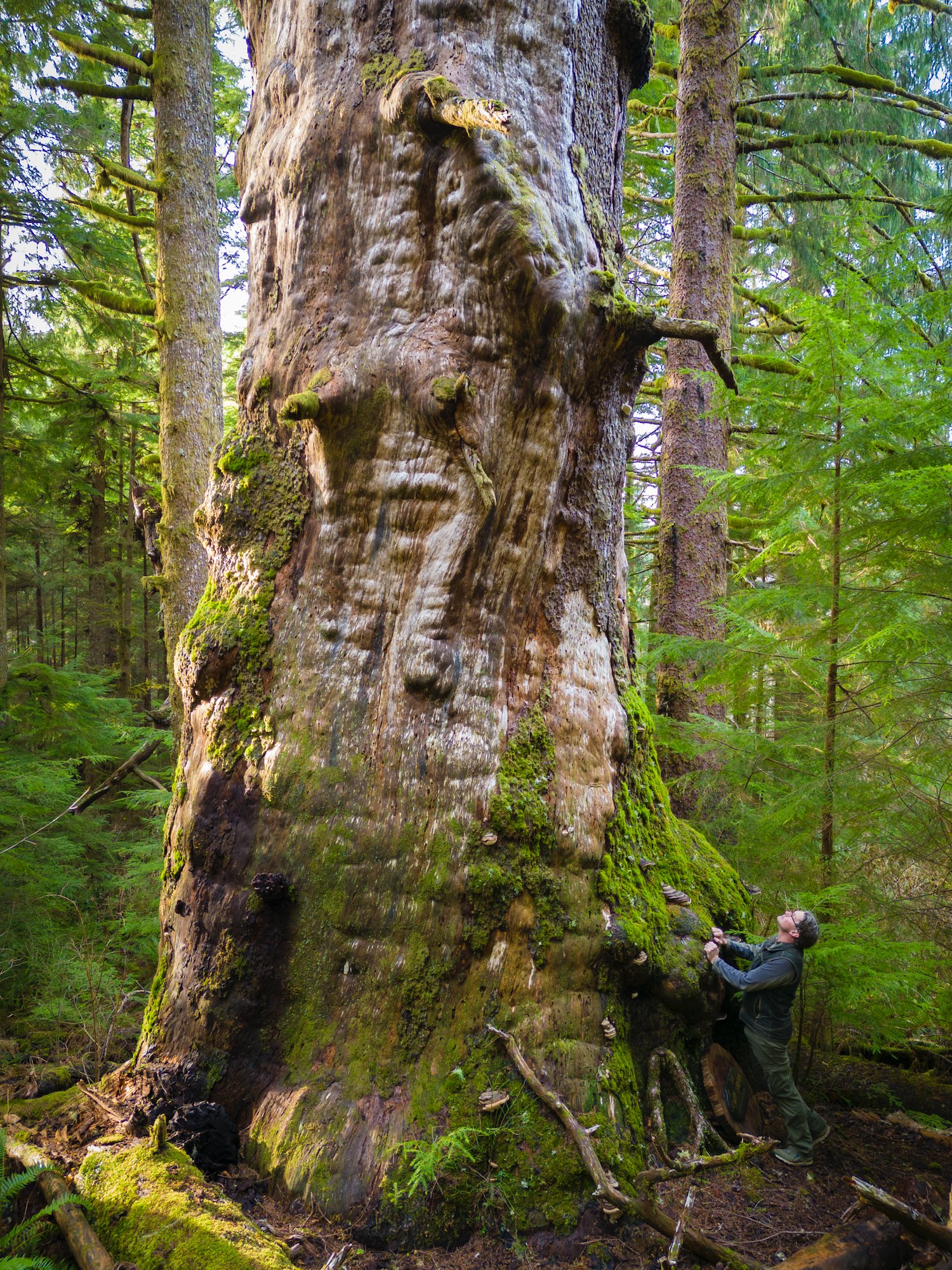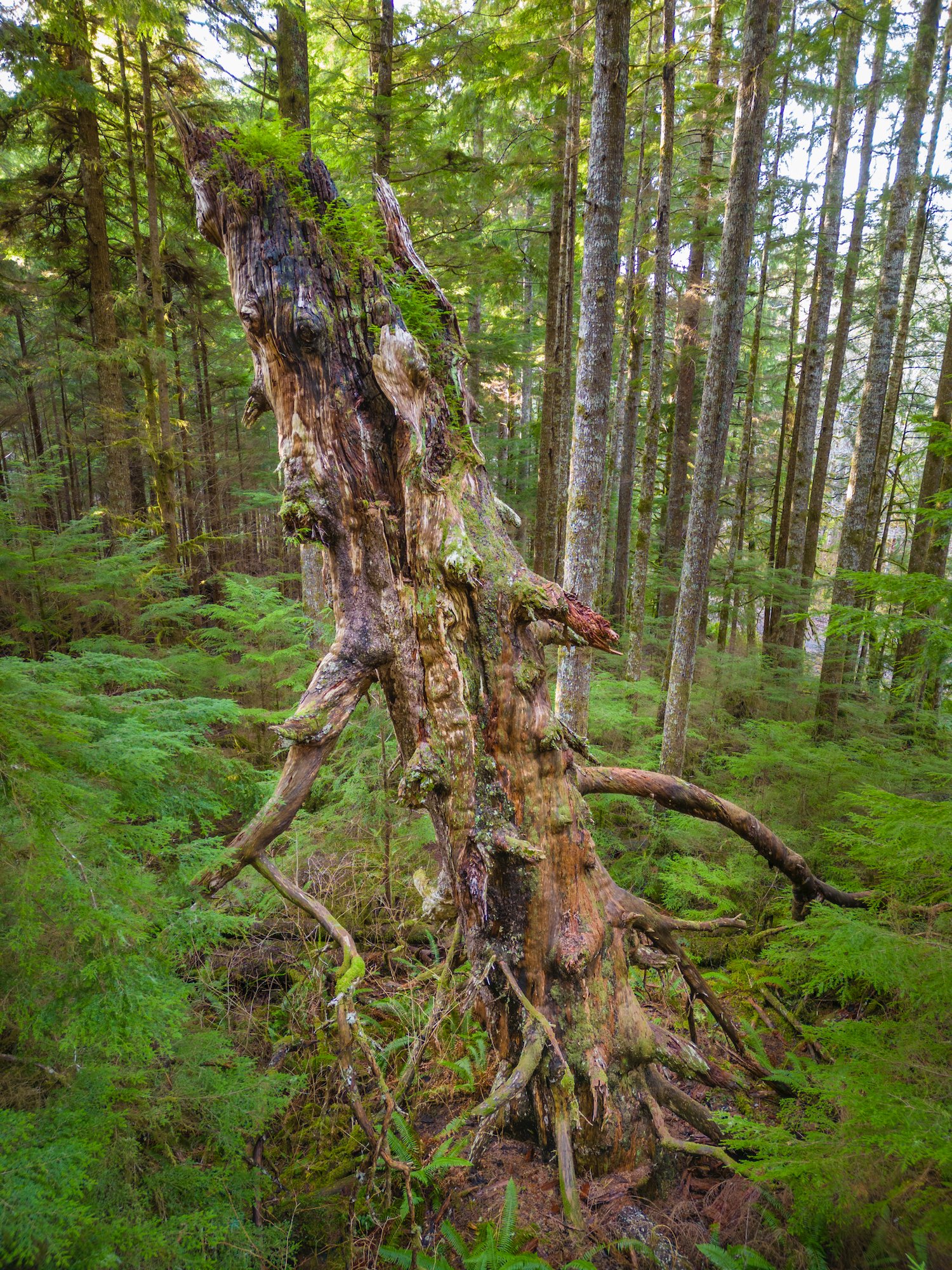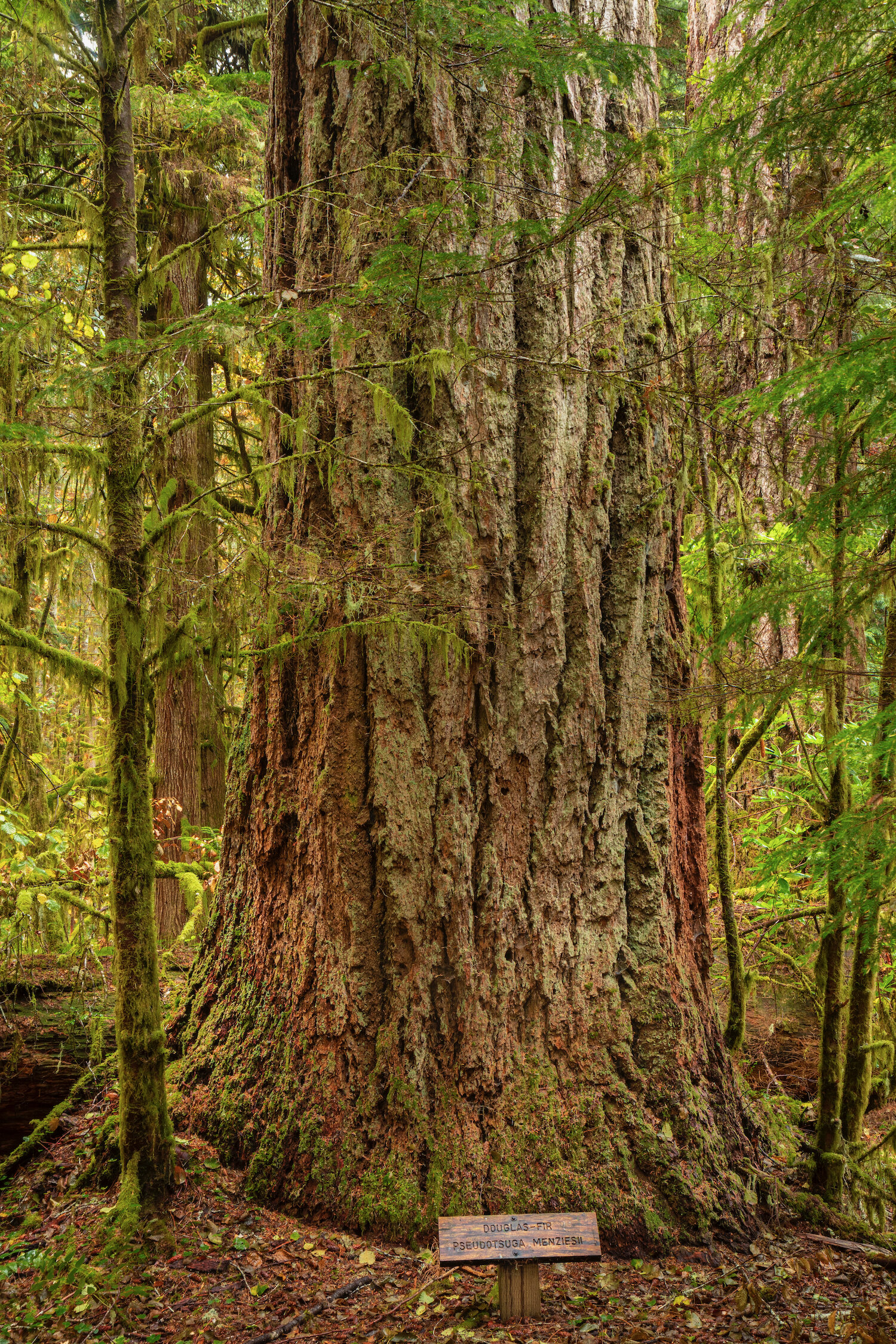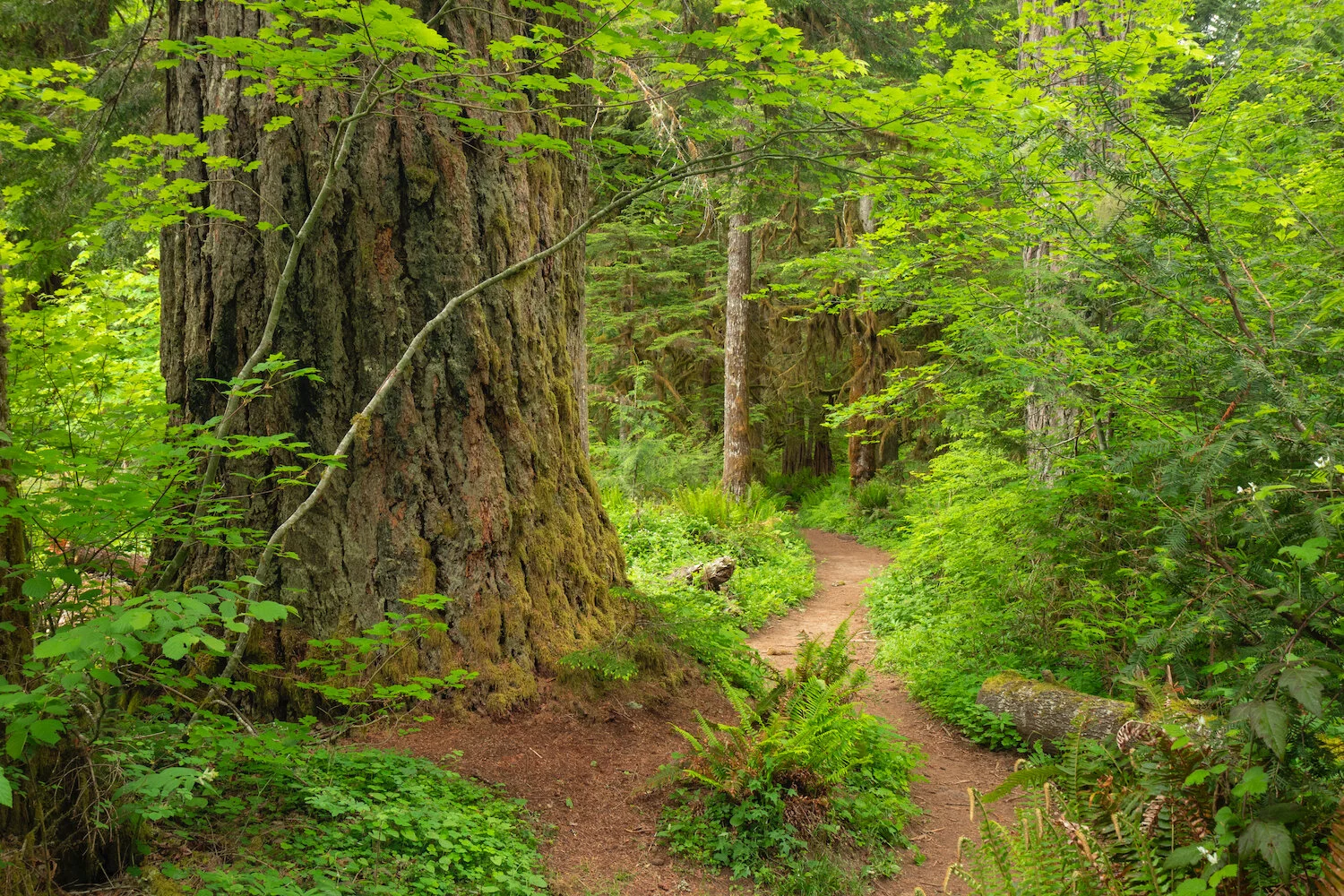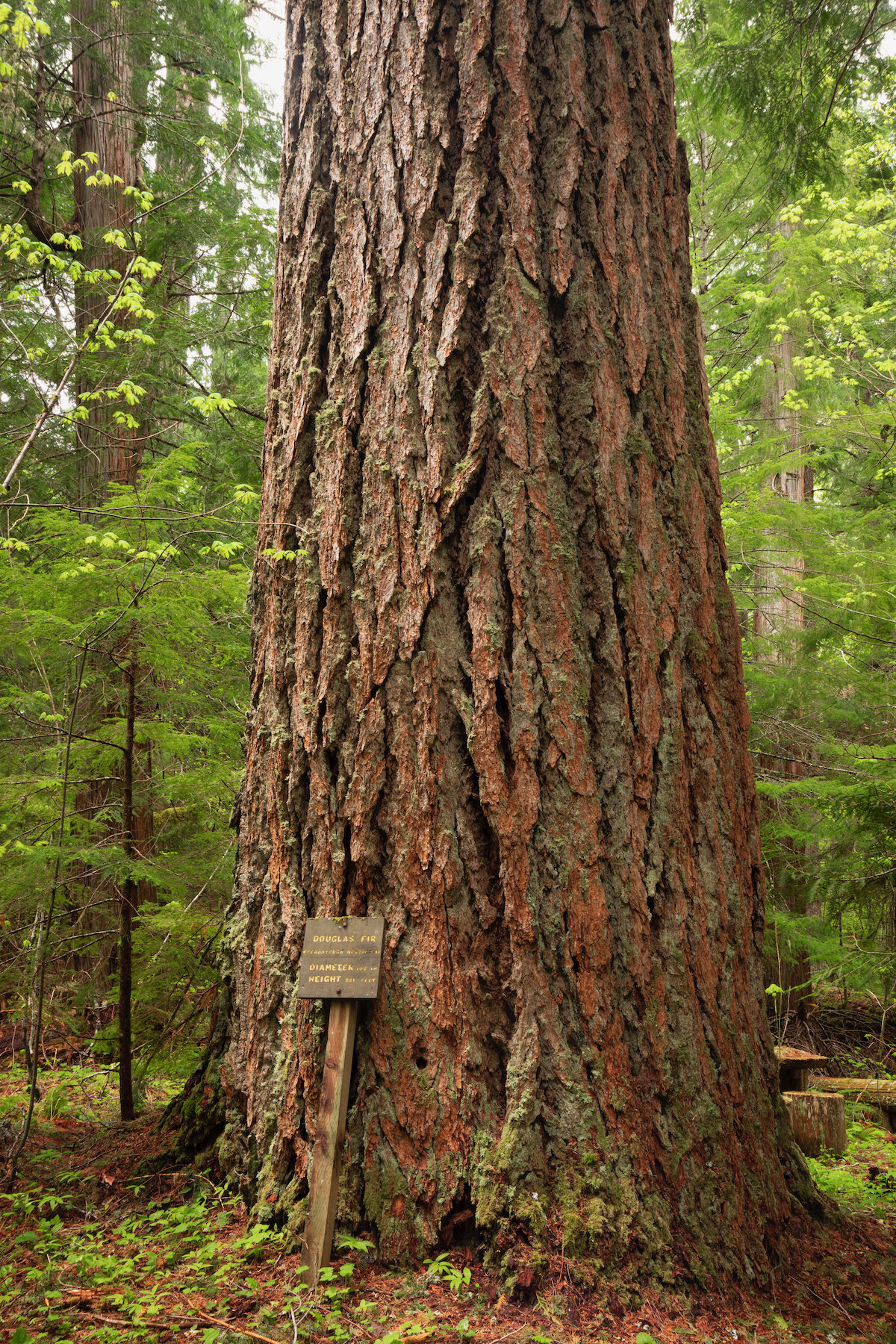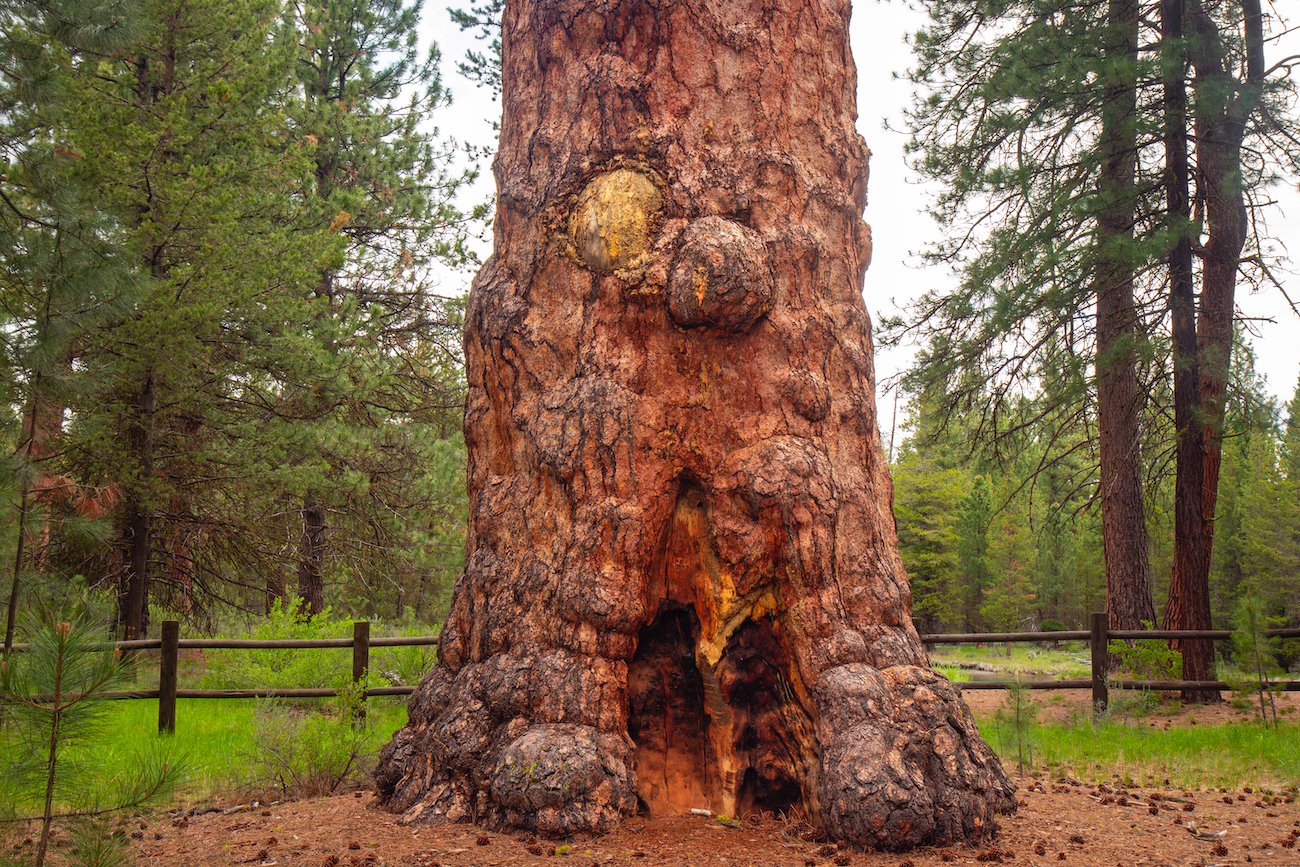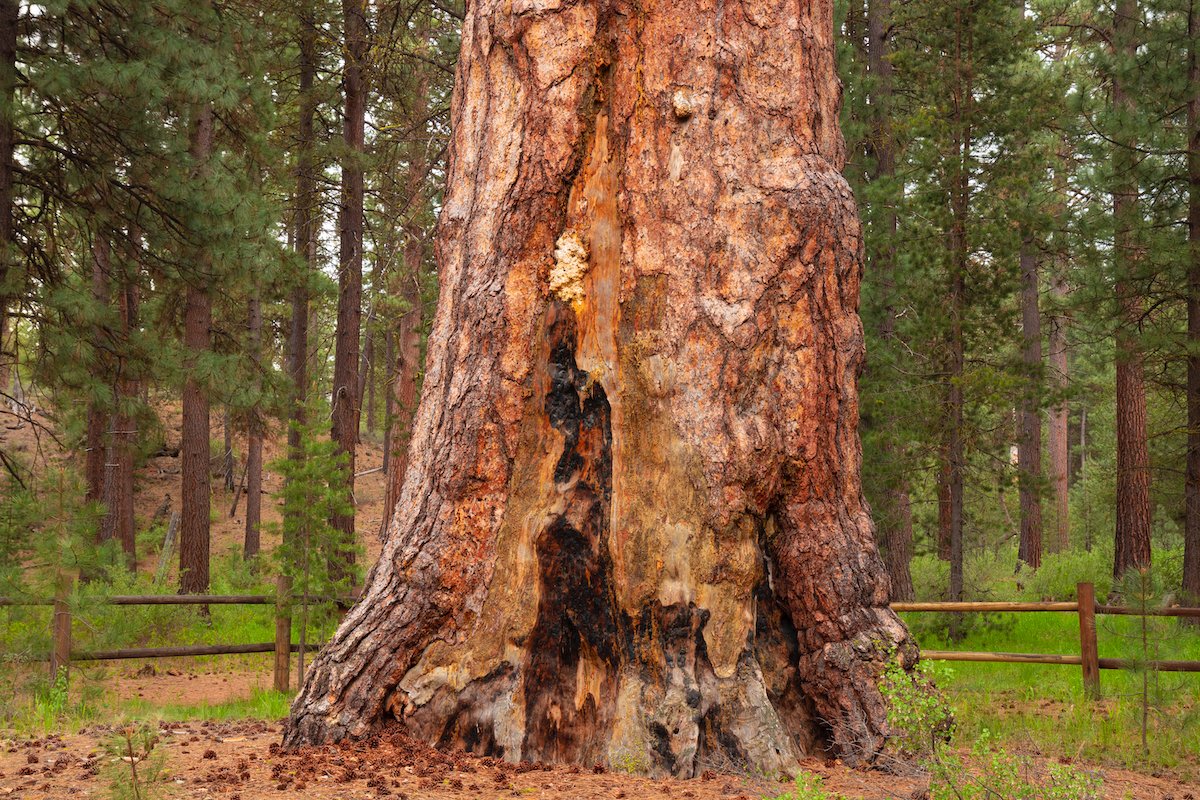oregon coast
Arcadia Cedar Grove
On Oregon’s wild northern coast, a grove of large western redcedars resides in relative obscurity. Despite the widespread logging that has affected the region, the trees in this recently discovered grove remain intact. In order to protect their wild state, I’ll refrain from providing exact directions, but suffice it to say, reaching them requires a bit of bushwhacking.
The trees here are hundreds of years old, and the grove contains the largest western redcedar in Oregon, the Arcadia Cedar. The cedar is likely over 800 years old and has been able to survive the many tsunamis that have crashed into Oregon’s coast over the last millennia because of its elevated position on a hill. The cedar was measured in 2010 by "Ascending the Giants" (an Oregon-based group of tree climbers and enthusiasts), officially making it Oregon's champion western redcedar at 17 feet in diameter, 152 feet tall, with a 70-foot crown spread.
Arcadia Cedar
Cape Perpetua - Siuslaw National Forest
Cape Perpetua, within the larger Siuslaw National Forest, contains the only entirely intact ancient forest watershed on the Oregon coast. The forests here are primarily dominated by Sitka spruce, moss, and lush ferns that are nourished by the mist and rain during the long, wet winter months.
Several creeks have cut into the landscape, creating steep hillsides that filter water down the slopes and protect trees from windstorms that rock the coast. The biggest trees are located near these creek banks, including the 550-year-old “Giant Spruce of Cape Perpetua” on Cape Creek, which measures 40 feet in circumference and 165 feet tall. This tree began its growth as a seedling on a nurse log, which decomposed over many years, leaving the tree with what appear to be “feet” reaching the ground.
More giant Sitka spruces and Douglas firs can be found on both the south end of the Gwynn Creek Trail and the bicycle-friendly Cummins Creek. These trails offer magnificent glimpses into what the entire Oregon coastal forest looked like a couple centuries ago.
Giant Spruce of Cape Perpetua
Klootchy Creek Sitka Spruce Giant
The Klootchy Creek Sitka Spruce Giant (also known as the “Klootchy Creek Giant” or the “Seaside Spruce") is a nearly 800-year-old giant that used to hold the title of Oregon's biggest tree. A violent windstorm in 2006 caused a large portion of rotted wood to break free from the tree at the site of an old lightning scar, and one year later, the tree fell victim to a second windstorm that broke off the trunk about 80 feet from the ground. In February 2011, the Oregon Parks Department had an additional 40 feet or so of the remaining snag cut off, due to concerns about decaying wood falling from the trunk and putting visitors at risk.
Though no longer rising to its 200-foot height, the tree's 17-foot-diameter trunk and two fallen sections still convey the giant spruce's massive size to visitors. The downed portions have been left in place to serve as nurse logs for a new generation of Klootchy Creek giants. At its full height, it shared the title of the world’s largest Sitka spruce with the Quinault Lake Spruce (and possibly the Queets Spruce) in Washington’s Olympic National Park.
Klootchy Creek Sitka Spruce Giant (or Seaside Spruce)
Cape Meares
The old-growth forests of coastal Oregon contain incredible groves of Sitka spruce, a tree whose natural range hugs the ocean. Cape Meares is a small headland on the northern coast with two famous spruces among the many that call this place home.
The Octopus Tree is a 300-year-old, tentacled spruce with several long branches reaching up to the sky. It has a circumference of more than 45 feet, and its odd shape gave it the status of an Oregon state heritage tree.
The Cape Meares Giant, also known as “Big Spruce,” was designated the state champion in 2008 when the Klootchy Creek Spruce (featured in the post above) lost its upper half. The Cape Meares Giant also has a missing top, but its giant girth gives it enough bulk to make it the “official biggest spruce in Oregon.” It is 144 feet tall, 48 feet in circumference, 15 1/2 feet in diameter, and estimated to be 750 to 800 years old. Recent findings have upended the Cape Meares Giant’s title as Oregon’s largest Sitka spruce. Today, Oregon's actual largest Sitka spruce is located in nearby Oswald West State Park.
Octopus Tree
Cape Meares Big Spruce (Cape Meares Giant)
oswald West state park
A short 10-minute drive from Cannon Beach, Oswald West State Park shares much in common with its southern neighbor, Cape Perpetua. Both are coastal parks dominated by old-growth Sitka Spruce forests, which grow near streams flowing into the ocean. Unlike Cape Perpetua, however, Oswald West contains tall ocean-facing cliffs, eroded over millennia by the constant pounding of the ocean. Though many tourists visit primarily to hike the dramatic cliffs along the Cape Falcon Trail, several of the park’s flat and accessible southern trails, which traverse the lowland forests, offer some of the best old-growth hiking in coastal Oregon.
The watershed between Short Sand Creek and Necarney Creek, where these short trails are located, is filled with giant trees contoured into weird and interesting shapes. The entire area is incredibly verdant and teeming with vegetation. The region’s ample precipitation allows small, photogenic plants, leaves, and ferns to dominate the forest floor for much of the year, growing on and around the ancient trees.
rockaway big tree
Another icon of the northern coast, the hike to Rockaway Big Tree was once a trail through a swampy Sitka Spruce and hemlock forest to the base of the massive western red cedar. However, as is the case with many famous trees, the roots and shrubs surrounding it began to suffer from heavy foot traffic. Now, an elevated boardwalk trail circles and protects the giant, guiding visitors through the diverse regional flora. The cedar is one of the most twisted and gnarliest in the state, with unique growths and forms on all sides.
coast range
Rector Ridge Spruce
Strangely located on the high slopes above God’s Valley east of Manzanita is one of the largest spruces in the entire state. Even when it was alive, this local legend had a particularly primordial appearance, with burls, knots, and other outgrowths throughout its trunk. The tree is an incredible sight for its size, as it retains its mass and hardly tapers for 60 or so feet.
The spruce met its dramatic end during the Great Coastal Gale of 2007—a windstorm that felled countless trees throughout the Pacific Northwest. As the wind rocked the tree back and forth, its top section broke off and was thrown nearly vertically, piercing the ground so violently that it still stands upright years later, despite its heavy size. This pierced section is large enough to resemble its own tree.
Rector Ridge Spruce
Broken top of the Rector Ridge Spruce piercing the ground.
valley of the giants
Tucked in a remote section of Oregon’s Coast Range, the mythical-sounding “Valley of the Giants” definitely lives up to its name. The trail through this 51-acre grove of gigantic Douglas firs and hemlocks is less than two miles long but weaves around several trees over 20 feet in circumference and through one fallen giant that grew to 35 feet in circumference before it fell decades ago. These 400-500 year-old titans are a rare sight in a land that has been logged for the better part of the last 150 years, which makes seeing them an absolute privilege for big tree enthusiasts. Access to the trailhead requires navigating a series of logging roads with gates that are occasionally locked, so it is advisable to call the BLM office for directions and updates prior to departure.
Doerner Fir (formerly Brummit Fir)
The Doerner Fir (formerly named the Brummit Fir) is certainly one of Oregon’s largest Douglas Firs and its tallest, topping out at nearly 330 feet high. Its jaw-dropping height makes it one of the tallest non-redwood trees in the world. The fir grows on BLM land between the towns of Coquille and Reston and is best accessed through a series of logging and forest roads in the mountains, approaching from the east. Considering its age, the tree appears remarkably healthy, and its deeply furrowed bark is characteristic of similarly ancient firs. The trail to the specimen is quite short but maneuvers around other giant Douglas Firs, making the trip to the record-breaking tree a very mesmerizing experience.
Doerner Fir (formerly named the Brummit Fir)
Doerner Fir (formerly named the Brummit Fir)
Rogue River - Siskiyou National Forest
Located at the southwestern corner of the state, the twin Rogue River National Forest and Siskiyou National Forest cover a vast section of the Southern Oregon Coast Range. The various wild rivers and their waterfalls (profiled here) are important natural landmarks, as are the old-growth forests and their many giant trees. Two areas, in particular, are noteworthy.
The first, Coquille River Falls Research Natural Area near Forest Road 33, was established in the 1940s to protect virgin old-growth Port Orford Cedar groves. Despite their name, these trees are actually cypresses and are native to this region of Oregon. They can reach huge sizes like other species in the Northwest if left to grow uninterrupted. Many of these giants are found on the steep slopes of the Research Natural Area by bushwhacking off-trail. However, the trail to Coquille River Falls is also a good launching-off point for exploration.
Elk Creek Big Tree Observation Area
The second section of particular interest in Rogue River—Siskiyou National Forest is the Big Tree Observation Area located farther north on Forest Road 33. This place contains the largest Port Orford Cedar known. To access it, visitors can either hike about 1.5 miles from the Elk Creek Falls area along the Big Tree Trail (#1150) or drive up a logging road to the Observation Area. Either way, it’s a must-see for giant tree enthusiasts.
The main attraction is the Elk Creek Champion, which measures 12 feet in diameter at breast height and tapers very slowly on the way up, making it much larger than the surrounding trees. Other giant conifers also grow nearby with identification signs in front of them, including a huge Douglas Fir and other western hemlocks.
Douglas Fir (Pseudotsuga Menziesii)
Elk Creek Champion - Largest Port Orford Cedar Tree
cascade range (north)
Herman Creek Trail
One of the better old-growth hikes in the Columbia River Gorge is a tale of two forests. The first, from the trailhead to the five-mile mark, passes through a burn area devastated by the 2017 Eagle Creek Fire. Here, the hike traverses several beautiful, towering waterfalls (profiled here), while the charred remaining tree trunks of the forest present a haunting landscape. Miraculously, the fire spared the largest trees—a mix of firs, hemlocks, and cedars—located between mile five and seven. This second section is where the hike truly pays off. Cedar Swamp Camp is a particular highlight, featuring several massive cedars growing on a level bench.
Cedar Swamp Camp
Old Salmon River Trail
Wedged between two narrow mountains at the foothills of Mount Hood in northern Oregon, the Old Salmon River Trail parallels the Salmon River for an all-too-brief couple of miles through lush vegetation. Although there are a handful of massive trees, the path is not packed with giants. Rather, the hike is known for its verdant appearance, where moss, ferns, and leaves cling to nearly every surface. The area enjoys the consistent precipitation generated by weather patterns around Mount Hood, and the plants here are evidence of this beneficial relationship.
Willamette National Forest
Several pockets of beautiful forest are located in the foothills of the Cascade Range in Oregon. No one area or trail can claim the crown as the big tree mecca, but the 1,678,031 acres that make up Willamette National Forest contain a variety of environments typical of high-elevation forests.
Highway 20 cuts right through the mountains, with access to groves of Douglas Fir, perhaps the most iconic species of the region. One famous tree, the Soda Fork Giant, is nearly 11 feet in diameter, making it the second largest Douglas Fir known in Oregon. A visit to this giant is also complemented by a short, 1/4-mile tour around the Hackleman Old Growth Grove, a prime example of a high-elevation fir-dominated forest.
Nearby on Highway 20, some of Oregon’s largest Alaska yellow cedars grow, scattered on a scenic mountain basin. The Echo Basin Trail (or Echo Mountain Trail) is an underutilized and sparsely maintained trail, remarkable for its handful of huge cedars and for the flower bloom that envelopes the forest during the summer.
Hackleman Old Growth Grove
Soda Fork Giant
Echo Basin Trail
McKenzie River Trail
One of the most beautiful rivers in all of Oregon, the McKenzie River, is located in the heart of Willamette National Forest. This river has a wonderful blue hue to it, with old-growth forests growing on its banks. The trail that runs parallel to the river contains a series of interlocking sections that can be accessed at various points, or the whole thing can be hiked 24 miles one-way. Koosah and Sahalie Falls, two large cascades, are the most popular sections, as I have described elsewhere. For ancient forest enthusiasts, however, the trail’s best trees are located north of Clear Lake and about a half-mile north of Tamolitch Falls (Blue Pool). The ancient incense-cedars near Blue Pool are particularly incredible, with some trees reaching up to seven feet in diameter, and they grow on the border of an ancient lava flow that devastated the area long ago.
Tamolitch Falls (Blue Pool)
Opal Creek Trail
Long embroiled in the preservation movement of the 1980s, Opal Creek is a remarkably beautiful area of old-growth forests, scenic river channels, and pristine water. Most visitors are attracted to the Little North Fork of the Santiam River and Opal Creek, which appear turquoise-colored due to the minerals found in them. It’s also home to the Merten Mill, a decommissioned historic 1940s sawmill. Some of the equipment and infrastructure can still be found along the trail.
The full hike, from the trailhead gate to the end and back, is 10.5 miles round-trip. Hiking the entire trail is recommended, as it ends in a section named Cedar Flats, a riverside oasis where some of the largest trees exist.
Cedar Flats
Lookout Creek Old Growth Trail (H.J. Andrews Experimental Forest)
A pocket of old-growth forest north of Highway 126 near McKenzie Bridge has been the site of a decades-long research project conducted by the US Forest Service to learn about the ecological interactions within forests, rivers, and watersheds. The entire site is approximately 15,800 acres in size, and most of it is left without trails to allow scientists to study the area undisturbed. However, there is one trail that bisects the forest. The Lookout Creek Old Growth Trail initially crosses a creek and climbs high above for sweeping views.
cascade range (south)
Shale ridge Trail & Constitution grove
Southwest of Bend and Mount Bachelor, the Waldo Lake Wilderness area near Willamette National Forest contains a captivating, nearly level hike through prime old-growth forest. At five miles roundtrip, the Shale Ridge Trail is a simple walk that initially passes some very large Douglas firs between 5 and 10 feet in diameter. It travels south by the North Fork Middle Fork of the Willamette River and terminates in a boggy wetland often populated by mosquitos. This bog contains the stunning reward—a wonderful grove of ancient western red cedars up to 10 feet in diameter.
The interesting and aptly named Constitution Grove is located three miles west of the Shale Ridge Trail on Forest Road 19. This diverse stand of Douglas firs and western hemlock were nascent trees at the country’s founding but, like the U.S., they have developed and grown over the past 250 years. Small plaques are nailed to some of the larger trees, which bear the names of a few of the country’s founding fathers.
Shale Ridge Trail
Constitution Grove
Joe Goddard Nature Trail
It’s difficult to name a more impressive giant Douglas Fir grove in Oregon as impressive as the one circled by the Joe Goddard Nature Trail. Though the road signs on National Forest Road 24 provide directions to the trailhead, it is evident that few people make the visit. The path is easy to follow, with the signs being gradually consumed by the forest, providing a sense that one is on a lost trail. A few notable trees have been measured and are simply extraordinary in size—some nearly 120 inches in diameter and others over 250 feet tall.
LaPine State Park
Thirty minutes south of Bend, Oregon sits the lovely LaPine State Park, a gorgeous example of desert-subalpine forest located east of the Cascades. The climate here is less rainy, more snowy, and temperatures are far more varied than the verdant forests west of the Cascades. Trails navigate around and follow the winding route of the Deschutes River. Lodgepole and Ponderosa pines dominate here, but the park is notable for one tree, Big Red (or Big Pine), thought to be the largest Ponderosa pine in the world. This giant is 29 feet in circumference and estimated at more than 500 years old.
Big Red/Big Pine
Big Red/Big Pine
Emile Big Tree & Bill Taft Tree
Two notable trees in the Umpqua National Forest, located in the Emile Creek watershed area, are a must-see for big-tree completists. Both are located east of Glide and north of Little River Road/FR-27.
The first, Emile Big Tree, is 12 feet in diameter and 200 feet tall—certainly one of the largest in the area. The grove that surrounds it is impressive, and the many snags are characteristic of old-growth forest environments.
The second, Bill Taft Tree, is fairly close to Grotto Falls (profiled in this guide), as the crow flies, but accessed via a series of winding dirt roads. This tree also grows in a tiny yet similarly majestic grove of giants.
Bill Taft Tree
Emile Big Tree
Extra Hikes
ecola state park
Ecola State Park in northern Oregon is primarily known for its vertical cliffs, beaches, and sea stacks. The best way to experience the natural diversity of the park is on the Tillamook Head Trail, which connects Seaside, Oregon in the north to Ecola Point in the south, nearly the entire length of the park. Along the way, it climbs approximately 1,000 feet above steep cliffs that grant distant and panoramic views of the ocean and the sea stacks below. In addition, its northern half traverses old-growth forests comprised primarily of Sitka Spruce trees. The forest is not as remarkable as those in Oswald West State Park or Siuslaw National Forest, but a few individual trees are particularly large and noteworthy.
Silver falls state park
Silver Falls State Park is one of Oregon’s most beloved and historic parks that preserves the waterfalls and forests in the canyon carved by Silver Creek. The park is primarily known for the numerous waterfalls that visitors access by hiking the stunning Trail of Ten Falls—profiled in this guide. Of lesser interest to most people are the ancient forests that surround the canyon walls. Big Douglas Firs and other moss-laden trees grow on the flatter, higher-elevation portions of the park. Though none of the trees are record-setting, the forest here is old and lush, owing to its sheltered existence in the canyon. For big tree hunters, the largest trees can be found on the Rim Trail between South Falls and North Falls Viewpoint.


